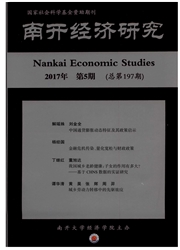

 中文摘要:
中文摘要:
基于Hansen的面板门槛模型,采用中国1994--2013年省际面板数据构造非线性面板数据模型,研究城镇化、地方财政支出规模对城乡收入差距的影响。结果表明,城镇化、地方财政支出规模对城乡收入差距的影响存在显著的门槛特征。从城镇化的门槛值来看,城镇化发展并没有促进城乡收入差距收敛,只是其对城乡收入差距的影响强度会下降;从地方财政支出规模的门槛值来看,在低财政强度区间经济增长会缩小城乡收入差距,但是在高财政强度区间经济增长会拉大城乡收入差距。因此,加快发展新型城镇化,调整地方财政支出结构,是缩小城乡收入差距的关键。
 英文摘要:
英文摘要:
Based on Hansen's Panel Threshold Model, this paper builds a nonlinear panel data model to make a research into the influence of the urbanization and local fiscal expenditure scale on the urban-rural income gap by analyzing the interprovincial panel data from 1994 to 2013. The study shows that the influences of urbanization and local fiscal expenditure scale on the urban-rural income gap have apparent threshold effects. According to the threshold value of urbanization, the urbanization doesn't help to narrow the urban-rural income gap, but its influence on the gap declined. According to the threshold value of the local fiscal expenditure scale, the economic growth can help to narrow the urban-rural income gap when it runs at a low financial level but enlarge the gap at a high financial level. So it's the key to narrow down the urban-rural income gap to speed up the development of urbanization and make adjustment to the structure of the local fiscal expenditure.
 同期刊论文项目
同期刊论文项目
 同项目期刊论文
同项目期刊论文
 期刊信息
期刊信息
